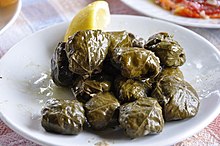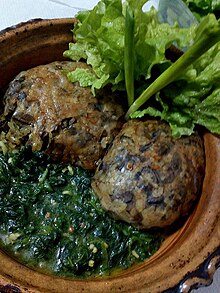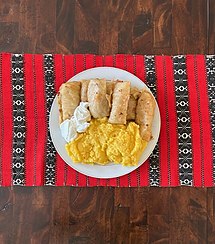 | |
| Type | Dolma |
|---|---|
| Course | main course |
| Place of origin | Turkey |
| Region or state | Middle East,Europe |
| Serving temperature | hot or cold |
| Main ingredients | cabbage leaves, rice, mince meat |
| Variations | With cabbage leaves, mince meat and rice filling (served hot) |
Sarma (Turkish for "wrapping" or "rolling") is a traditional food in Ottoman cuisine – nowadays, Turkish, Greek, Levantine / Arabic, Armenian, etc. – made of vegetable leaves rolled around a filling of minced meat, grains such as rice, or both. It is commonly marketed in the English-speaking world as stuffed grape leaves, stuffed vine leaves, or stuffed cabbage leaves. The vegetable leaves may be cabbage, patience dock, collard, grapevine, kale or chard leaves. Sarma is part of the broader category of stuffed dishes known as dolma, and has equivalents (such as the Polish Gołąbki) in Eastern European cuisines from the northern Baltic through Romania.
Terminology and etymology

Sarma is a Turkish word meaning "wrapping.
Sarma made with grape leaves are called yaprak sarması (lit. 'leaf sarma') or yaprak dolması (lit. 'leaf dolma') in Turkish, yabraq (يبرق) or waraq 'inab (ورق عنب) lit. 'vine leaves' or waraq dawālī (ورق دوالي) in Arabic. yarpaq dolması (lit. 'leaf dolma') in Azerbaijani, and dolme barg-e mo (دلمه برگ مو, lit. 'vine leaf dolma') in Persian. In Assyrian it is called ܦܪܵܟܼܹܐ (prakhe) which refers to the fact that the rice is rubbed in the grape leaves. In Armenian, they are called մսով տերեւափաթաթ (missov derevapatat), տերեւի տոլմա (derevi dolma), թփով դոլմա (t'pov dolma) and տերեւի սարմա (derevi sarma). In Greek they are generally called ντολμάδες (dolmathes) but may also be known as γιαπράκια (yaprakia), γιαπράκια γιαλαντζί (yaprakia yalandzi), ντολμαδάκια (dolmathakia), ντολμαδάκια γιαλαντζί (dolmathakia yalandzi), σαρμάδες (sarmathes), or σαρμαδάκια (sarmathakia).
Stuffed leaves without meat are sometimes called yalanchi or yalanchy sarma (transliterated Armenian) or yalancı dolma (Turkish), which means "liar's (sarma or dolma)". Vişneli yalancı dolması is a variation of stuffed vine leaves where the rice is seasoned with cinnamon, allspice, and mint. The dolmas are slowly cooked together with morello cherries (vişne), and plums may be used also.
In Bulgarian and Macedonian cabbage and grapevine leaves are not usually differentiated.
Stuffed chard leaves are called pazı dolması in Turkey and dolmas de pazi by Sephardi Jews who settled in Argentina.
Background
A grapevine leaf roll is a dish consisting of cooked grapevine leaves wrapped around a variety of fillings.
Vine leaves may also be used to wrap stuffed celery root. Before wrapping, the celery root is stuffed with rice that has been seasoned with cinnamon, salt, pepper, allspice, pine nuts, and sugar (this type of rice is called iç pilav). Dried fruits like fig and apricot may be added to the rice mixture before the celery root is stuffed, wrapped, and baked in the oven. Some variations may include quince.
Regional and national variants
Albania
In Albania, sarme is cigar-shaped and is often made in the northern regions, but can be found all through. It is typically made of cabbage or grape leaves and filled with meat, rice, and spices. It can be served with yogurt or a yogurt-based drink. It can be a meal for special occasions or during the winter. In southern Albania, a lemon slice can be added while cooking the stuffing.
Bulgaria

In Bulgaria, besides the two main rolled varieties—cabbage sarma (usually eaten in winter) and grape leaf sarma (in spring and summer)—there is also a layered variety called drob sarma (дроб сарма, literally 'liver sarma'). Drob sarma is a dish of finely chopped offal (liver and lung), rice, browned onions, herbs, baked in an oven, and after a while covered with a mixture of eggs and yogurt and baked again. The dish may be covered or even wrapped in caul fat before being baked. All sarma dishes can be served with fresh yogurt on the side.
Croatia
In Croatia sarma is common throughout the country though there are regional variations. Sarma is typically a meat dish filled with a combination of beef, pork, and rice, wrapped in sauerkraut leaves. In some regions, fresh cabbage is used. Sinjski arambašići, from Sinj, is ground beef wrapped in sauerkraut leaf, with no grains or pork. Sarma is a winter staple and is also traditionally served on New Year's Eve. In Croatia, sarma are eaten with mashed potatoes, bread, corn bread, or sour cream. A sauce made of horseradish mixed with sour cream, mayonnaise, salt, and apple cider vinegar is also used as a condiment.
Cyprus
In Cyprus koupepia, also known as dolmades, are made with ground beef and pork, rice, and a tomato and cinnamon sauce all wrapped in a grape leaf. Koupepia arrived in Cyprus with Greek immigrants in 1200 BC. Cyprus koupepia use a creamy tart tomato and cinnamon sauce instead of the Greek avgolemono sauce of eggs mixed with lemons.
Greece
In Greece, the dish is now known as dolmades. In ancient Greece, fresh tender fig leaves called "thrion" were used instead of grape leaves to create the dish. In some parts of Greece today, fig leaves are still used. Nowadays, the fillings vary, like they probably did in ancient times as well. Rice is the most common filling today, which was unavailable in the region in ancient times. It has been conjectured that another type of grain, such as spelt, might have been used instead.
Romania and Moldova

In Romania and Moldova, sarmale (singular sarma) are popular in all historical regions, including Moldavia, Transylvania, and Wallachia. This original Turkish dish slowly became integrated into Romania's culture after the Romanian principalities became vassals of the Ottoman Empire. Sarmale are a central part of Romanian cuisine and are the national dish of Romania. Romania has a large garden and farm culture and Romanians love to make sarmale as they grow many of the ingredients such as cabbage near their home. The Romanian poet Păstorel Teodoreanu wrote a poem about sarmale, comparing it to a “bouquet of spices". Sarmale in Romania are also popular because of their fulfillment which allows one batch of sarmale to last for a long time such as more than a week for multiple people. Each usually consists of minced pork, rice, onion, eggs, thyme, and dill rolled in a leaf, usually a cabbage leaf. The baking dish is lined with chopped cabbage and sauerkraut layered with bacon or pork belly and the cabbage rolls, then topped with more sauerkraut and dill sprigs. The cooking water is poured over the assembled tray, a mixture of sauerkraut juice and seasonings. When preparing this meal for visitors it is critical to have the sarmale soak up the flavor of the smoked meat to make it as tasty as possible. To do this people will let their "sarmale" sit with the smoked meat in the baking dish for a couple of days. During the fasting season of Lent there are alternative versions of sarmale that might replace the pork with smoked fish and include vegetables such as carrots by grating them. It is typically accompanied by mămăligă (polenta) and smântână (sour cream). It is a traditional dish for Easter and Christmas meals.
Serbia

In Serbia, the classic form of stuffed cabbage rolls has minced meat, which could be pork or beef. In the winter fermented cabbage leaves (sauerkraut) are utilized as a wrap. During the spring and summertime there is a replacement of the sauerkraut with grapevine leaves. Grapevine leaves are used during the summer as they are easier to use than sauerkraut which is usually made in the winter. In Serbia, sarma are the first appetizers at celebrations such as the slavas. A vegetarian version of sarma is eaten during the observance of Lent and on Christmas Eve. These vegetarian sarma can be composed of rice, onions, potatoes, walnuts, spices, and sauerkraut as a wrap.
Amasya and Tokat, Turkey
In the Turkish provinces of Amasya and Tokat, sarma is prepared in a style similar to maklouba, with different fillings. One version made with fava beans is called bakla sarma. The filling for this variant from Amasya is made with dried fava beans and a coarsely ground wheat called yarma cooked in a seasoned tomato sauce. The wrapped sarma are layered over bone-in lamb chops and slowly simmered in the cooking liquid. The finished dish is served upside down. A similar variation from Tokat is stuffed with a lentil, bulgur, and chickpea filling. Homemade red pepper paste may be substituted for some of the tomato paste.
Crimean Tatars (Crimea, Ukraine)
In the cuisine of the Crimean Tatars there is a dish called "sarma", which is prepared from grape leaves. The name of the dish means "wrapped in". Stuffing: minced beef or lamb, rice, chopped onion, salt, ground pepper. Sometimes tomato paste, some greens, carrots, and other spices can be added to the filling. Due to the influence of Ukrainian cuisine (holubtsi), sarma is also sometimes prepared from cabbage leaves. Dolma for Crimean Tatars is stuffed pepper, the filling for dolma is the same as for sarma.
Danube Swabians
Danube Swabians have a version of sarma with cabbage leaves, ground pork, onion, garlic, rice and tomato sauce.
See also
References
- Engin Akin, Essential Turkish Cuisine, 2015, ISBN 9781617691720, s.v. "Dolma and Sarma"
- "Yarpaq dolması". Resept.az (in Azerbaijani). 31 October 2012. Archived from the original on June 25, 2013. Retrieved July 11, 2019.
- "Search Entry".
- ^ Mladenova, Olga (1998). Grapes and Wine in the Balkans: An Ethno-linguistic Study. Otto Harrassowitz Verlag. ISBN 9783447040372.
- Marks, Gil (2010-11-17). Encyclopedia of Jewish Food. HMH. ISBN 978-0-544-18631-6.
- "Vişneli Yaprak Sarma tarifi - Haber - Mutfağım". Kanal D. 26 June 2013. Archived from the original on 2014-01-18. Retrieved 2018-06-29.
- Migros Türkiye. Üçgen Pazı Dolması. Retrieved 2018-06-29.
- Diner, Hasia R.; Cinotto, Simone (2018). Global Jewish Foodways: A History. U of Nebraska Press. ISBN 978-1-4962-0609-1.
- "Zeytinyağlı, Kuru Meyveli Kereviz Dolması". Sabah. Retrieved 2018-06-30.
- Nursel'in Evi. Ayvalı Kereviz Dolması Tarifi. Retrieved 2018-06-30.
- ^ "17 Most Popular Albanian Foods to Try". Nomad Paradise. 14 August 2022. Retrieved 18 October 2022.
- ^ "Albanian Food: 12 Must-Try Traditional Dishes of Albania". Travel Food Atlas. 27 September 2022 . Retrieved 18 October 2022.
- ^ Dogan, Yunus; Nedelcheva, Anely; Łuczaj, Łukasz; Drăgulescu, Constantin; Stefkov, Gjoshe; Maglajlić, Aida; Ferrier, Jonathan; Papp, Nora; Hajdari, Avni; Mustafa, Behxhet; Dajić-Stevanović, Zora; Andrea, Pieroni (2015). "Of the importance of a leaf: the ethnobotany of sarma in Turkey and the Balkans". Journal of Ethnobiology and Ethnomedicine. 11: 26. doi:10.1186/s13002-015-0002-x. PMC 4428097. PMID 25890379.
- Palmer, Sarah (17 January 2022). "Tirana is Albania's food capital: Here's what you have to try". EuroNews.Travel. Retrieved 18 October 2022.
- "Bulgarian Drob Sarma". Archived from the original on 2021-10-31. Retrieved 2021-10-31.
- "5 important facts you need to know about Croatian sarma". Archived from the original on 2013-08-19. Retrieved 2023-03-13.
- Antoliš, Iva (2022-01-18). "Three ways of making sarma - The ultimate Croatian dish". SpeakCRO - learn Croatian online. Retrieved 2023-03-21.
- "Cyprus Recipes- Koupepia". 10 March 2019.
- Liacopoulou, Ivy (2007-11-11). "Koupepia me Ampelofylla (Cypriot Stuffed Grape Leaves)". Kopiaste..to Greek Hospitality. Retrieved 2023-03-21.
- Giannopoulos, Eli K. (2014-01-02). "The traditional Egg-lemon sauce (Greek Avgolemono) recipe". My Greek Dish. Retrieved 2023-03-21.
- Ricotti, Eugenia Salza Prina (2007). Meals and Recipes from Ancient Greece. Getty Publications. p. 51. ISBN 978-0-89236-876-1.
- "Romania - Land | Britannica". www.britannica.com. Retrieved 2023-03-20.
- "14 mouth-watering Romanian foods that everyone should try". rolandia.eu. Retrieved 2023-03-20.
- ^ Dos, Adina (December 17, 2019). "Sarmale are a Must Have for Christmas in Romania - Dave's Garden". www.davesgarden.com. Retrieved 2023-03-21.
- "Povestea sarmalelor. Unde au apărut, cum s-au răspândit şi de ce varianta românească se face cu carne de porc". adevarul.ro (in Romanian). 5 July 2019. Retrieved 2023-03-21.
- ^ "Sarmaua, un preparat care a călătorit. Unde s-au născut sarmalele?". historia.ro (in Romanian). Retrieved 2023-03-21.
- "Romanian Stuffed Cabbage (Sarmale)".
- ^ "You are being redirected..." www.serbia.com. 4 December 2012. Retrieved 2023-03-21.
- "Serbian Recipes for Orthodox Lent".
- Nevena (2022-01-03). "Posna Sarma/Vegan Cabbage Rolls". The Balkan Hostess. Retrieved 2023-03-20.
- Show TVundefined (Director). Nursel'in Mutfağı - Baklalı Dolma Tarifi / 25 Şubat. Event occurs at 738 seconds. Retrieved 2018-06-29.
- "Mercimekli Yaprak Sarma tarifi (Tokat) - Haber - Mutfağım". Kanal D. 28 December 2012. Archived from the original on 2014-04-11. Retrieved 2018-06-29.
- Qırımtatar yemekleri: Cарма, 6 December 2022, retrieved 2023-07-18
- Duhatschek, Katharina; Duhatschek, Monica (2019). The Danube Swabian Cookbook (2nd ed.).
External links
- Heike Milhench (2007). Flavors of Slovenia: Food and Wine from Central Europe's Hidden Gem. Hippocrene Books. p. 142. ISBN 978-0-7818-1170-5.
- Arab cuisine
- Cabbage dishes
- Greek cuisine
- Levantine cuisine
- Balkan cuisine
- Ottoman cuisine
- Stuffed vegetable dishes
- Turkish cuisine
- Bulgur dishes
- Bacon dishes
- Christmas food
- Easter food
- Moldovan cuisine
- Armenian cuisine
- Azerbaijani cuisine
- Lenten foods
- Iranian cuisine
- Saudi Arabian cuisine
- Georgian cuisine
- Sephardi Jewish cuisine
- Sephardi Jewish culture in Argentina
- Mizrahi Jewish cuisine
- Romani cuisine
- National dishes